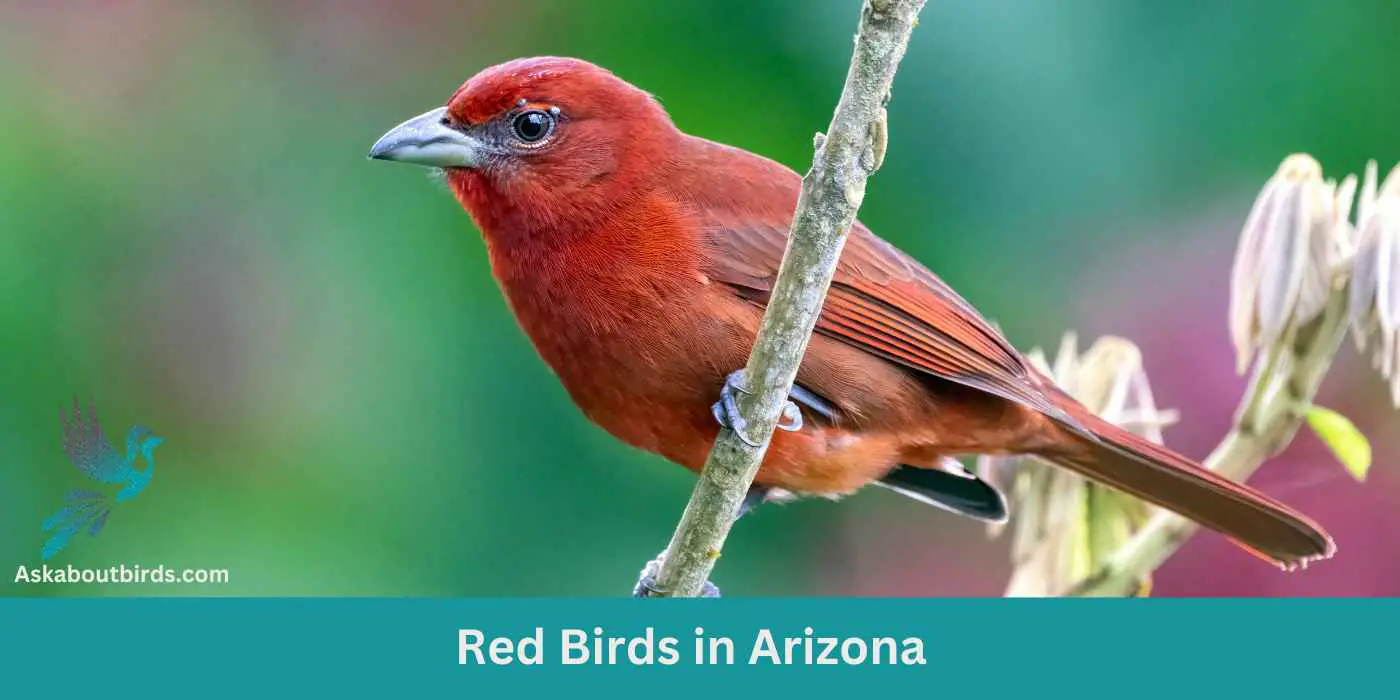From the sun-soaked Sonoran Desert to the cool Ponderosa pine forests of the north, Arizona’s unique geographical contrasts create a wide range of habitats.
This topographical diversity, combined with its position at the confluence of tropical and temperate zones, has made the state a converging point for bird species from different climates.
Red Birds Found In Arizona
Arizona boasts a varied terrain of deserts, canyons, and high mountain ranges. The state’s numerous riparian zones serve as critical migratory routes and breeding grounds, attracting an array of bird species throughout the year.
Northern Cardinal


| Feature | Measurement |
|---|---|
| Scientific Name | Cardinalis cardinalis |
| Length | 8.3 – 9.1 in |
| Wingspan | 9.8 – 12.2 in |
| Weight | 1.19 – 2.29 oz |
The Northern Cardinal is an iconic North American bird, easily recognized by its vibrant color and melodious song.
Appearance: Male Northern Cardinals are a brilliant scarlet red, while females display a more subdued reddish olive. Both sexes have a distinctive black ‘mask’ on their face around the bill and a pointed crest on their head. The bird’s beak is robust, cone-shaped, and bright orange in color.
Diet: Northern Cardinals are primarily granivorous, with a diet largely consisting of seeds and grains. They also eat fruits and insects. These birds typically feed off the ground and are frequent visitors to bird feeders.
Reproduction: Northern Cardinals are monogamous, and a pair will breed together for life. The female typically builds a well-hidden nest in a dense thicket or shrub. She lays 2-5 eggs per clutch, which she incubates for around two weeks.
Summer Tanager


| Feature | Measurement |
|---|---|
| Scientific Name | Piranga rubra |
| Length | 6.7 in |
| Wingspan | 28 to 30 cm |
| Weight | 29 g |
The Summer Tanager is a medium-sized songbird admired for its radiant plumage and melodious song.
Appearance: Male Summer Tanagers are an impressive bright red, while females and juveniles present a softer, yellow-orange color. Both genders have a large, slightly hooked bill and relatively short tail.
Diet: Summer Tanagers primarily feed on insects, including bees and wasps, which they catch in flight or pick off vegetation. They are also known to eat fruits and berries, making them helpful in controlling pest populations and seed dispersal.
Reproduction: The female Summer Tanager builds a loose, shallow cup-shaped nest out of twigs and grass, usually hidden in the foliage of trees. The female typically lays 3-5 eggs, which she will incubate for about two weeks.
Vermilion Flycatcher
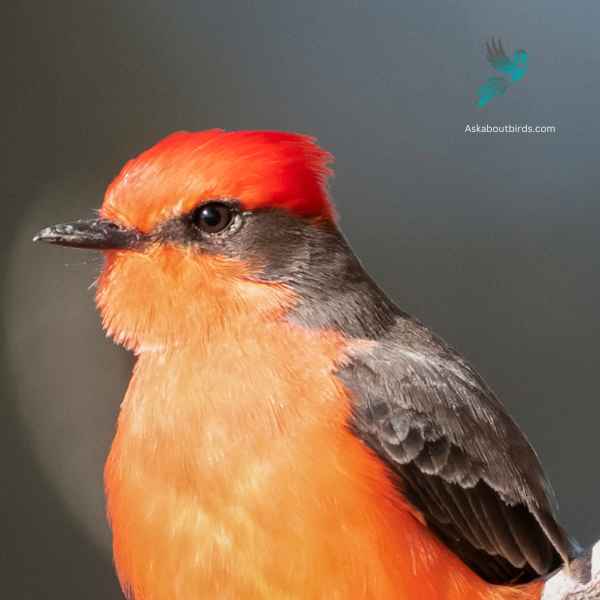

| Feature | Measurement |
|---|---|
| Scientific Name | Pyrocephalus obscurus |
| Length | 5.1–5.5 in |
| Wingspan | 9.4 to 9.8 in |
| Weight | 11 to 14 g |
The Vermilion Flycatcher is a small and colorful bird native to the Americas. The male Vermilion Flycatcher is a striking sight, displaying a vibrant red plumage on its head, breast, and underparts, contrasting with its brown wings and black tail below. Females, on the other hand, have more muted colors, featuring a pale yellowish belly and grayish-brown upperparts.
Vermilion Flycatchers are known for their lively and acrobatic flight displays, which they perform during courtship or to defend their territories. They often sing a series of soft, whistled notes while engaged in these aerial displays. They construct cup-shaped nests, usually in shrubs or low trees, where females lay their eggs and raise their young.
Hepatic Tanager
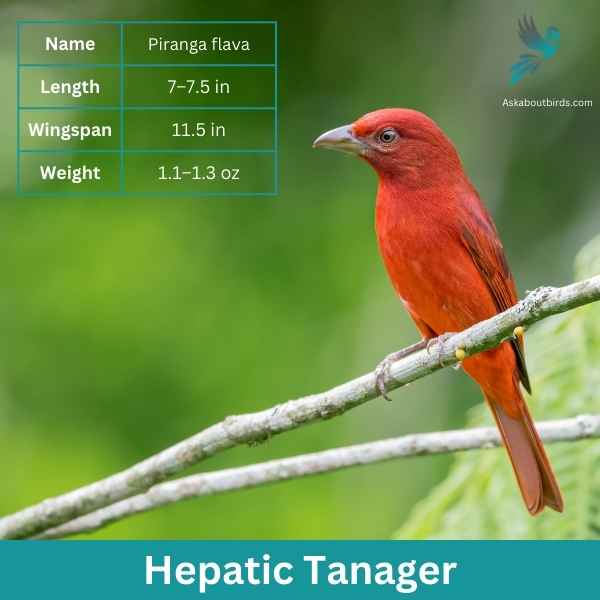
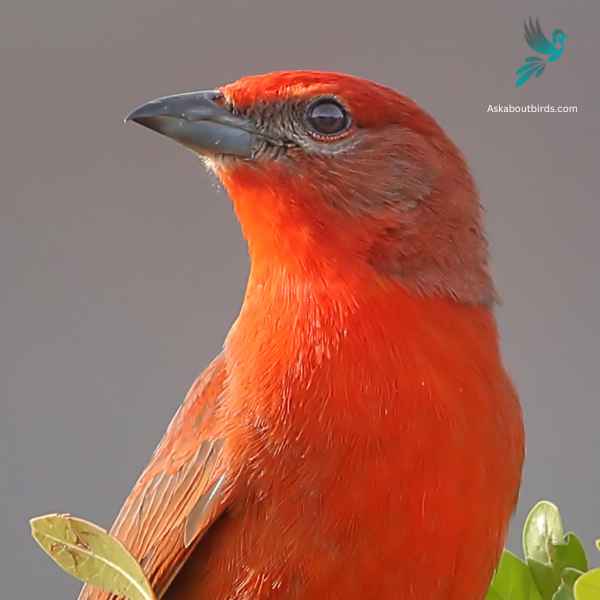
| Feature | Measurement |
|---|---|
| Scientific Name | Piranga flava |
| Length | 7–7.5 in |
| Wingspan | 11.5 in |
| Weight | 1.1–1.3 oz |
The Hepatic Tanager is a robust and brightly colored songbird found primarily in pine-oak woodlands of the American Southwest and Mexico.
Appearance: Male Hepatic Tanagers are a rich reddish-brown or “liver” color, from which they get their name (hepatic means liver-colored). Their wings and tail are more dusky, while females are a more muted yellow-orange, with a gray back and wings. Both sexes have a stout, pointed bill.
Diet: These tanagers primarily eat insects, but they also consume a fair amount of fruit and berries. They often forage by perching quietly and then making short flights to capture prey or pluck fruit.
Reproduction: Hepatic Tanagers nest in trees, often in a concealed location such as a dense clump of needles in a pine tree. The nest is a shallow cup made of twigs, grass, and pine needles. The female typically lays a clutch of 3 to 4 pale blue or greenish eggs. Both parents share feeding duties once the eggs hatch.
Pyrrhuloxia

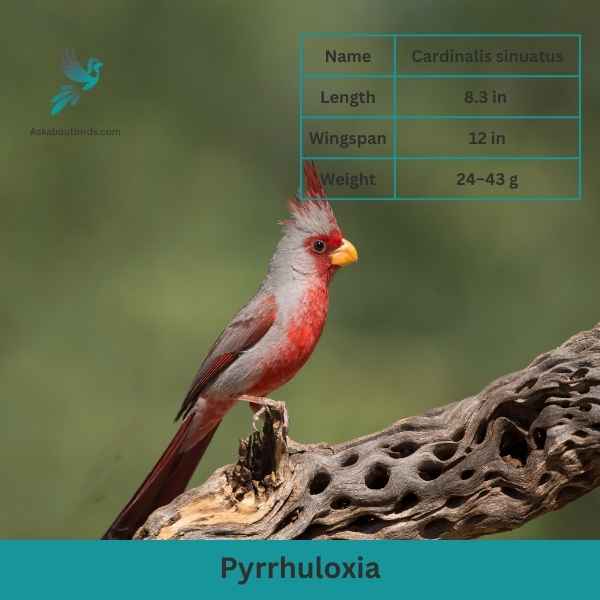
| Feature | Measurement |
|---|---|
| Scientific Name | Cardinalis sinuatus |
| Length | 8.3 in |
| Wingspan | 12 in |
| Weight | 24–43 g |
The Pyrrhuloxia, also known as the Desert Cardinal, is a medium-sized songbird native to the southwestern United States and northern Mexico. It is closely related to the Northern Cardinal but possesses its own unique characteristics. The Pyrrhuloxia is named after its vibrant red crest and mask-like face markings, similar to that of the Northern Cardinal. However, its overall coloration is more muted, with a grayish body and reddish wings and tail.
Pyrrhuloxias are known for their distinct vocalizations, which include a variety of songs and calls. Males often sing from elevated perches to defend their territories and attract mates. They also engage in aggressive displays to establish dominance.
House Finch


| Feature | Measurement |
|---|---|
| Scientific Name | Haemorhous mexicanus |
| Length | 5–6 in |
| Wingspan | 8–10 in |
| Weight | 0.6–0.9 oz |
The House Finch is a small songbird widely distributed across North America and is commonly found in urban and suburban areas.
Appearance: Males of this species are brightly colored with crimson faces and throats, which can extend to the chest and back, while their flanks have streaks. The female is streaked brown and lacks the red coloring. Both have a square-tipped tail and a distinctively long, flat-topped bill.
Diet: House Finches primarily eat seeds, grains, and berries. They have a particular fondness for sunflower seeds and can be commonly seen at bird feeders. Occasionally, they will also consume insects, especially during the breeding season.
Reproduction: House Finches are cavity-nesters and might choose ledges, vents, ledges, and other urban settings. They might also utilize trees or shrubs. Their nests can be made of a wide array of materials, from feathers to twigs.
Red Crossbill

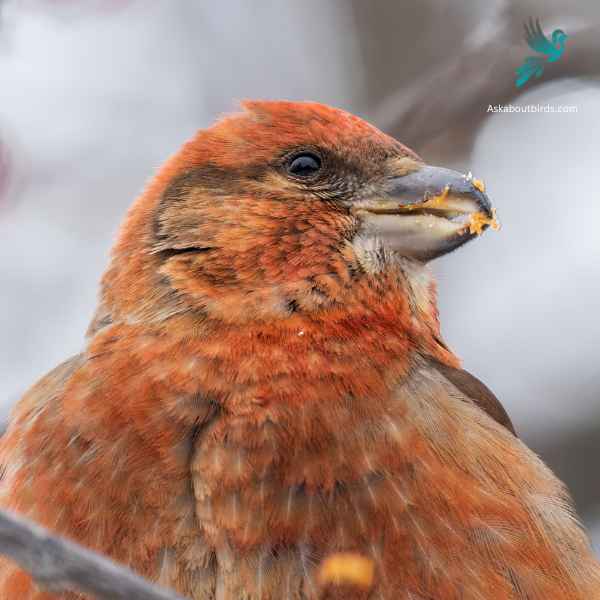
| Feature | Measurement |
|---|---|
| Scientific Name | Loxia curvirostra |
| Length | 5.5–7.5 in |
| Wingspan | 9.8–10.6 in |
| Weight | 0.9–1.4 oz |
The Red Crossbill is a distinctive finch known for its unusual bill, which has evolved to extract seeds from conifer cones.
Appearance: Males are typically bright red or orange, while females are greenish-yellow or olive. Both genders have the characteristic crossed bill, which they use to expertly extract seeds from tightly closed conifer cones.
Diet: Red Crossbills primarily feed on the seeds of coniferous trees, such as spruce, pine, and fir. Their specialized bills allow them to efficiently pry apart conifer cone scales to access the seeds.
Reproduction: Red Crossbills are somewhat nomadic and don’t adhere to a strict breeding schedule. Instead, they breed whenever and wherever food is abundant. Their nests are usually built on horizontal branches of conifer trees.
Red-faced Warbler
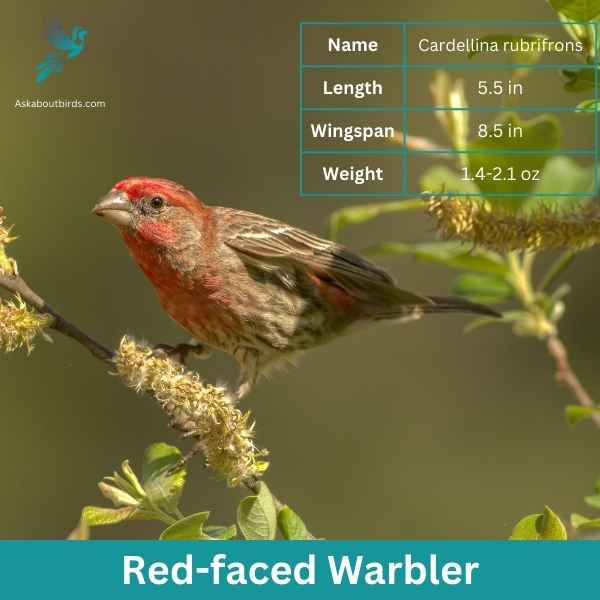

| Feature | Measurement |
|---|---|
| Scientific Name | Cardellina rubrifrons |
| Length | 5.5 in |
| Wingspan | 8.5 in |
| Weight | 1.4-2.1 oz |
The Red-faced Warbler is a vibrant and lively songbird recognized for its stark contrast between its bright red face and its cool-toned body.
Appearance: The Red-faced Warbler is characterized by its bright red face, extending from its forehead to its throat. Its crown and nape are black, creating a striking contrast. The rest of its body is predominantly gray with white undersides, and the birds have a pair of white wing bars.
Diet: This warbler mainly feeds on insects and spiders. They actively forage in the tree canopy and, on occasion, on the forest floor, picking off prey from leaves, twigs, and bark.
Reproduction: Red-faced Warblers nest on the ground, hidden beneath shrubs or other vegetation. The nests are crafted using grasses, pine needles, and other fine materials, and lined with feathers.
Cassin’s Finch

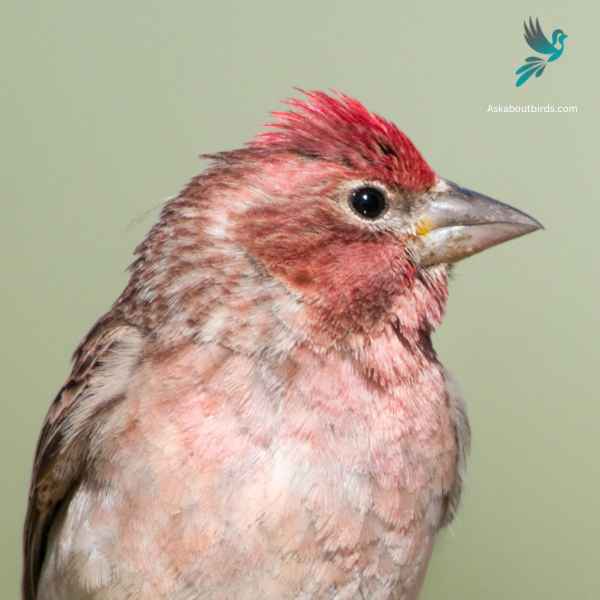
| Feature | Measurement |
|---|---|
| Scientific Name | Haemorhous cassinii |
| Length | 6.0-6.5 in |
| Wingspan | 9.5-10.5 in |
| Weight | 0.8-1.0 oz |
The Cassin’s Finch is a small songbird known for its melodic song and affinity for high-elevation forests.
Appearance: Male Cassin’s Finches are pinkish-red on the crown and throat, contrasting with their streaked brown back and wings. Females lack the bright coloring, appearing streaked brown throughout with a pale eyebrow stripe. Both sexes have a notched tail and a slightly curved bill.
Diet: Cassin’s Finches mainly feed on seeds, particularly from conifers. They also eat insects, especially during the breeding season. Their feeding habits often bring them to bird feeders where they readily eat sunflower seeds.
Reproduction: Cassin’s Finches nest in trees, preferring coniferous forests. The nest is made from twigs, grasses, and feathers. Typically, the female lays 3 to 5 eggs and handles most of the incubation. Both parents partake in feeding the fledglings once they hatch.
Where to Spot Arizona’s Red Birds
Arizona, with its diverse landscapes ranging from arid deserts to lush riparian zones, is a birdwatcher’s paradise, especially for enthusiasts seeking vibrant red birds. Here are some top spots known for avian diversity:
- Madera Canyon: Nestled in the Santa Rita Mountains, Madera Canyon is a hotspot for birdwatchers. With over 250 species recorded, it’s especially known for its hummingbirds, including the brilliant red Broad-billed Hummingbird.
- Sedona: This famous red rock city isn’t just visually stunning—it’s also a haven for numerous bird species. Oak Creek Canyon, in particular, provides the right habitats for species like the Summer Tanager.
- San Pedro Riparian National Conservation Area: Along the San Pedro River lies one of the most important and diverse birding areas in the U.S. The riparian habitat is a corridor for migratory species and boasts over 400 bird species throughout the year.
- Patagonia Lake State Park: Just a short distance from the Mexican border, this park offers a unique blend of desert and wetland birds. The famous Paton Center for Hummingbirds in the nearby town of Patagonia frequently sees the vibrant Red-faced Warbler.
- Huachuca Mountains: This range, part of the larger Sky Islands, is renowned for its birding opportunities. Canyons like Ramsey and Miller are great for spotting species like the Elegant Trogon and Northern Cardinal.
| State’s Red BirdsBest Spots to See Red Birds | |
|---|---|
| California’s Red Birds | 1. Point Reyes National Seashore 2. Salton Sea 3. Tule Lake National Wildlife Refuge |
| Nevada’s Red Birds | 1. Red Rock Canyon 2. Ash Meadows National Wildlife Refuge 3. Ruby Lake National Wildlife Refuge |
| Utah’s Red Birds | 1. Bear River Migratory Bird Refuge 2. Antelope Island State Park 3. Moab and the Colorado Riverway |
| New Mexico’s Red Birds | 1. Bosque del Apache National Wildlife Refuge 2. Valles Caldera National Preserve 3. Rattlesnake Springs |
| Colorado’s Red Birds | 1. Barr Lake State Park 2. Rocky Mountain National Park 3. San Juan National Forest |
FAQs on Red Bird Species Found in Arizona
Which bright red birds are commonly sighted in southeastern Arizona during the mating season?
During the mating season in southeastern Arizona, bird enthusiasts are often delighted by the presence of bright red bird, the Summer Tanager males, characterized by their bright red tail feathers and contrasting black wings. Additionally, the Painted Bunting, known for its colorful plumage, showcases bright red on its belly, making it one of the most beautiful birds in the region.
What are some recommended feed options to attract red birds to backyard feeders in Arizona?
For those looking to attract red birds such as the Northern Flicker and the male House Finch to their backyard bird feeders in Arizona, black oil sunflower seeds are highly recommended. These seeds are particularly appealing to many bird species, including those with a bright red chest or bright red feathers. Moreover, bird feeds that contain a mix of these eat sunflower seeds and, suitable for both small passerine birds and medium-sized birds, are effective in drawing these avian beauties.
Are there any red birds in Arizona with distinctive white wing features?
Certainly! The Painted Redstart, native to western North America including parts of Arizona, flaunts black and white wings along with a stunning red head and white belly. Additionally, the Northern Flicker, which can be spotted in Arizona’s mixed forests and dense forests, showcases a large white wing patch, complementing its red head and making it a standout among other birds.
What distinguishes a purple finch from other birds?
The purple finch is a unique bird, easily recognized by its distinct coloring. Both adult males and immature birds showcase varying shades of purple. Another distinguishing feature is their white wing bars. Purple finches are mostly found in regions spanning Central and South America.

